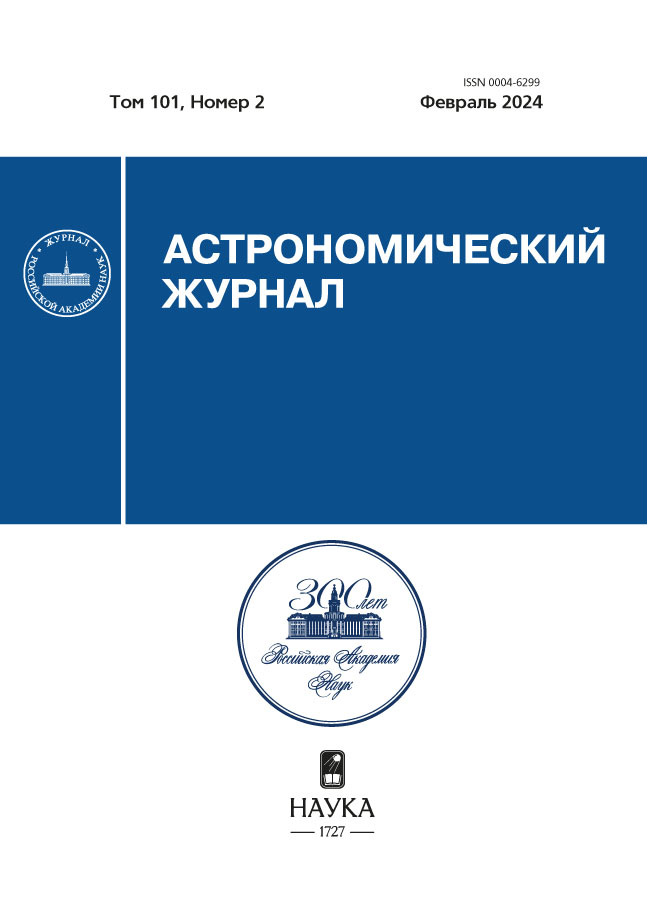Rotation of the apsidal line in the eclipsing system V1059 Cep
- Authors: Kozyreva V.S.1, Khamrakulov F.B.2,3, Burkhonov O.А.2,3, Bogomazov A.I.1, Satovskiy B.L.4
-
Affiliations:
- Lomonosov Moscow State University, Sternberg Astronomical Institute
- Ulugh Beg Astronomical Institute of the Academy of sciences of the Republic of Uzbekistan
- Samarkand State University
- State Space Corporation “Roscosmos”
- Issue: Vol 101, No 2 (2024)
- Pages: 101-110
- Section: Articles
- URL: https://rjmseer.com/0004-6299/article/view/647590
- DOI: https://doi.org/10.31857/S0004629924020048
- EDN: https://elibrary.ru/KTEYCK
- ID: 647590
Cite item
Abstract
Three light curves of the V1059 Cep eclipsing binary obtained in 2012, 2013 and 2021 were analyzed. We found the rapid apsidal motion in this system at the rate dw/dt = 7.2° per year. Assuming the equality of observed and theoretical apsidal motion rates we estimated physical characteristics of the components based on the data on their temperatures from the literature. According to our calculations the components are two very similar stars of the B7 V–B7.5 V spectral type with masses ≈(3.4 ± 0.3)M and age 180 ± 30 million years.
Keywords
Full Text
About the authors
V. S. Kozyreva
Lomonosov Moscow State University, Sternberg Astronomical Institute
Email: boa@astrin.uz
Russian Federation, Moscow
F. B. Khamrakulov
Ulugh Beg Astronomical Institute of the Academy of sciences of the Republic of Uzbekistan; Samarkand State University
Email: boa@astrin.uz
Uzbekistan, Tashkent; Samarkand
O. А. Burkhonov
Ulugh Beg Astronomical Institute of the Academy of sciences of the Republic of Uzbekistan; Samarkand State University
Author for correspondence.
Email: boa@astrin.uz
Uzbekistan, Tashkent; Samarkand
A. I. Bogomazov
Lomonosov Moscow State University, Sternberg Astronomical Institute
Email: boa@astrin.uz
Russian Federation, Moscow
B. L. Satovskiy
State Space Corporation “Roscosmos”
Email: boa@astrin.uz
Russian Federation, Moscow
References
- A.M. Черепащук, Тесные двойные звезды (М.: Физматлит, 2013).
- A.M. Cherepashchuk, Astron. Rep. Suppl. 66(S1), S5 (2022).
- T.E. Sterne, Monthly Not. Roy. Astron. Soc. 99, 662 (1939).
- A. Claret and A. Gimenez, Astron. and Astrophys. Suppl. Ser. 96, 255 (1992).
- K.F. Khaliullin and A.I. Khaliullina, Monthly Not. Roy. Astron. Soc. 382, 356 (2007).
- E.G. Lapukhin, S.A. Veselkov, and A.M. Zubareva, Peremennye Zvezdy. Prilozhenie 15(8), 1 (2015).
- S. Ehgamberdiev, Nature Astron. 2, 349 (2018).
- D.G. Monet, S.E. Levine, B. Canzian, H.D. Ables, et al., Astron. J. 125(2), 984 (2003).
- V.S. Kozyreva and A.I. Zakharov, Astron. Letters 27(11), 712 (2001).
- V.S. Kozyreva and A.I. Zakharov, Astron. Letters 32(5), 313 (2006).
- A.I. Khaliullina and K.F. Khaliullin, Soviet Astron. 28, 228 (1984).
- F. Anders, A. Khalatyan, C. Chiappini, A.B. Queiroz et al., VizieR On-line Data Catalog: I/349 (2019).
- A.G.A. Brown, A. Vallenari, T. Prusti, J.H.J. de Bruijne et al., Astron. and Astrophys. 649, id. A1 (2021).
- В.Л. Страйжис, Звезды с дефицитом металлов (Вильнюс: Мокслас, 1982).
- V. Straizys, Observatory 103, 223 (1983).
- W. van Hamme, Astron. J. 106, 2096 (1993).
- Д.Я. Мартынов, Затменные переменные звезды, под ред. В.Р. Цесевича (М.: Наука, 1971).
- E.C. Bellm, S.R. Kulkarni, M.J. Graham, R. Dekany, et al., Publ. Astron. Soc. Pacific 131(995), 018002 (2019).
- T. Levi-Civita, American J. Mathematics 59, 225 (1937).
- H.N. Russell, Monthly Not. Roy. Astron. Soc. 88, 641 (1928).
- М.С. Зверев, Б.В. Кукаркин, Д.Я. Мартынов, П.П. Паренаго, Н.Ф. Флоря, В.П. Цесевич, Переменные звезды, т. III (М.-Л.: Глав. ред. физ.-мат. литературы, 1947).
- Z. Kopal, Dynamics of close binary systems (Dordrecht, 1978).
- P. Swings, Zeitschrift für Astrophysik 12, 40 (1936).
- J.P. Zahn, Astron. and Astrophys. 41, 329 (1975).
- J.P. Zahn, Astron. and Astrophys. 57, 383 (1977).
- A. Claret and A. Gimenez, Astron. and Astrophys. Suppl. Ser. 81(1), 37 (1989).
Supplementary files















